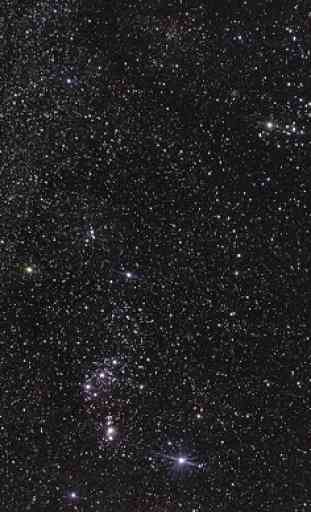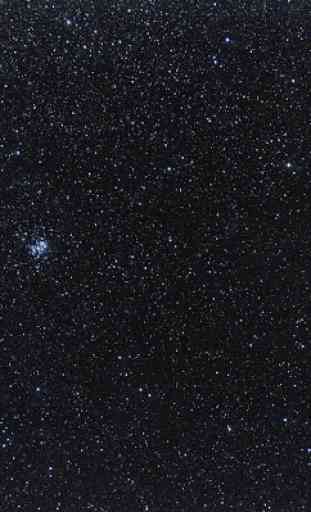DeepSkyCamera
This app is for astrophotography with your smartphone. You can take pictures with long exposure times like classical astrophotography with a DSLR or CCD/CMOS camera.
DeepSkyCamera takes pictures of the stars including a plan. You take the pictures in RAW format. Android uses the format DNG which can be processed with the well-known stacking software.
The phone must support RAW mode and must support manual settings. The app checks the support of RAW and manual settings during startup. Most of the cheaper phones doesn't support RAW and manual settings (like Samsung A and J, Huawei P10 lite). High end phones (Samsung S, Huawei P9, P10 and P20, LG G4 to G7) support RAW.
You can take light, flats, bias and dark frames. Its very similar to take pictures with a classical DSLR oder CCD/CMOS camera. After that you can do the post-processing with the stacking software as well as with softare for image processing.
App can focus automatically to infinity, hyperfocal and of course manual focus.
The maximum ISO depends on the camera sensor. Most sensors limiting the ISO value to 800. You can type in a higher value but the sensor wil set it to maximum ISO level of the sensor. LG G supports ISO until 6400, Google Pixel until 12800.
Its the same for the exposure time. Most of the sensors limiting the maximum exposure time to 30 seconds. You can type in a higher value but the sensor sets it to the highest possible value. Die LG G and Huawei P supports up to 30 seconds.
DeepSkyCamera takes only pictures. The app is not designed for the post-processing.
The sample picture shows constellation Ursa Major with the LG G4: 256 light frames each 30 sec which results in nearly 2 h exposure time in total. 170 dark framesan 100 flat frames applied. Processed with additional software. The second and third pic shows Cygnus taken with LG G4 and LG G6. The last pic shows M31 with LG G6 (M33 is on the bottom, double star cluster and Cassiopeia upper left).
You can use a simple portable mount for travel purposes like iOptron SkyTracker, AstroTrac or StarAdventurer. You put a ballhead on the top and add a clip from a small phone tripod. With the preview function (which is automatically visible after start) you can adjust the ballhead according to the brightest stars.
A manual is here:
https://www.deepskycamera.de/manual/DeepSkyCamera_manual_en.pdf
Problems with Samsung S9 / Note 8 / Note 9
Samsung S9 / Note 8 / Note 9 support RAW, but according to the so called Camera2API max exposure time is 0.1 sec.The build in camera stock app
provides
10 sec. Samsung extended the Camera2API with new methods and Java classes. I'm working on it to provide max exposure time of 10 sec on S9 / Note 8 / Note 9
DeepSkyCamera takes pictures of the stars including a plan. You take the pictures in RAW format. Android uses the format DNG which can be processed with the well-known stacking software.
The phone must support RAW mode and must support manual settings. The app checks the support of RAW and manual settings during startup. Most of the cheaper phones doesn't support RAW and manual settings (like Samsung A and J, Huawei P10 lite). High end phones (Samsung S, Huawei P9, P10 and P20, LG G4 to G7) support RAW.
You can take light, flats, bias and dark frames. Its very similar to take pictures with a classical DSLR oder CCD/CMOS camera. After that you can do the post-processing with the stacking software as well as with softare for image processing.
App can focus automatically to infinity, hyperfocal and of course manual focus.
The maximum ISO depends on the camera sensor. Most sensors limiting the ISO value to 800. You can type in a higher value but the sensor wil set it to maximum ISO level of the sensor. LG G supports ISO until 6400, Google Pixel until 12800.
Its the same for the exposure time. Most of the sensors limiting the maximum exposure time to 30 seconds. You can type in a higher value but the sensor sets it to the highest possible value. Die LG G and Huawei P supports up to 30 seconds.
DeepSkyCamera takes only pictures. The app is not designed for the post-processing.
The sample picture shows constellation Ursa Major with the LG G4: 256 light frames each 30 sec which results in nearly 2 h exposure time in total. 170 dark framesan 100 flat frames applied. Processed with additional software. The second and third pic shows Cygnus taken with LG G4 and LG G6. The last pic shows M31 with LG G6 (M33 is on the bottom, double star cluster and Cassiopeia upper left).
You can use a simple portable mount for travel purposes like iOptron SkyTracker, AstroTrac or StarAdventurer. You put a ballhead on the top and add a clip from a small phone tripod. With the preview function (which is automatically visible after start) you can adjust the ballhead according to the brightest stars.
A manual is here:
https://www.deepskycamera.de/manual/DeepSkyCamera_manual_en.pdf
Problems with Samsung S9 / Note 8 / Note 9
Samsung S9 / Note 8 / Note 9 support RAW, but according to the so called Camera2API max exposure time is 0.1 sec.The build in camera stock app
provides
10 sec. Samsung extended the Camera2API with new methods and Java classes. I'm working on it to provide max exposure time of 10 sec on S9 / Note 8 / Note 9
Category : Photography

Related searches




